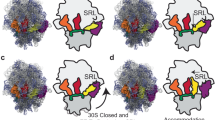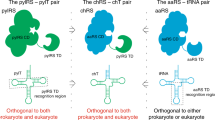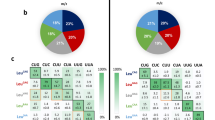Abstract
The involvement of tRNA structural elements beyond the anticodon in aminoacyl-tRNA (aa-tRNA) selection by the ribosome has revealed that substrate recognition is considerably more complex than originally envisioned in the adaptor hypothesis. By combining recent breakthroughs in aa-tRNA synthesis and mechanistic and structural studies of protein synthesis, we have investigated whether aa-tRNA recognition further extends to the amino acid, which would explain various translation disorders exhibited by misacylated tRNAs. Contrary to expectation, we find that natural amino acids misacylated onto natural but non-native tRNAs are selected with efficiencies very similar to those of their correctly acylated counterparts. Despite this, small but reproducible differences in selection indeed demonstrate that the translational machinery is sensitive to the amino acid–tRNA pairing. These results suggest either that the ribosome is an exquisite sensor of natural versus unnatural amino acid–tRNA pairings and/or that aa-tRNA selection is not the primary step governing the amino acid specificity of the ribosome.
This is a preview of subscription content, access via your institution
Access options
Subscribe to this journal
Receive 12 print issues and online access
$259.00 per year
only $21.58 per issue
Buy this article
- Purchase on Springer Link
- Instant access to full article PDF
Prices may be subject to local taxes which are calculated during checkout



Similar content being viewed by others
References
Ledoux, S. & Uhlenbeck, O.C. Different aa-tRNAs are selected uniformly on the ribosome. Mol. Cell 31, 114–123 (2008).
Ogle, J.M. & Ramakrishnan, V. Structural insights into translational fidelity. Annu. Rev. Biochem. 74, 129–177 (2005).
Rodnina, M.V. & Wintermeyer, W. Fidelity of aminoacyl-tRNA selection on the ribosome: kinetic and structural mechanisms. Annu. Rev. Biochem. 70, 415–435 (2001).
Crick, F.H. On protein synthesis. Symp. Soc. Exp. Biol. 12, 138–163 (1958).
Ramakrishnan, V. Ribosome structure and the mechanism of translation. Cell 108, 557–572 (2002).
Chapeville, F. et al. On the role of soluble ribonucleic acid in coding for amino acids. Proc. Natl. Acad. Sci. USA 48, 1086–1092 (1962).
Pape, T., Wintermeyer, W. & Rodnina, M.V. Complete kinetic mechanism of elongation factor Tu-dependent binding of aminoacyl-tRNA to the A site of the E. coli ribosome. EMBO J. 17, 7490–7497 (1998).
Kennell, D. & Riezman, H. Transcription and translation initiation frequencies of Escherichia-coli Lac operon. J. Mol. Biol. 114, 1–21 (1977).
Marshall, R.A., Aitken, C.E., Dorywalska, M. & Puglisi, J.D. Translation at the single-molecule level. Annu. Rev. Biochem. 77, 177–203 (2008).
Rodnina, M.V. & Wintermeyer, W. Ribosome fidelity: tRNA discrimination, proofreading and induced fit. Trends Biochem. Sci. 26, 124–130 (2001).
Gromadski, K.B. & Rodnina, M.V. Kinetic determinants of high-fidelity tRNA discrimination on the ribosome. Mol. Cell 13, 191–200 (2004).
Hirsh, D. & Gold, L. Translation of the UGA triplet in vitro by tryptophan transfer RNA's. J. Mol. Biol. 58, 459–468 (1971).
Cochella, L. & Green, R. An active role for tRNA in decoding beyond codon:anticodon pairing. Science 308, 1178–1180 (2005).
Ledoux, S., Olejniczak, M. & Uhlenbeck, O.C. A sequence element that tunes Escherichia coli tRNA(Ala)(GGC) to ensure accurate decoding. Nat. Struct. Mol. Biol. 16, 359–364 (2009).
Murakami, H., Ohta, A. & Suga, H. Bases in the anticodon loop of tRNA(Ala)(GGC) prevent misreading. Nat. Struct. Mol. Biol. 16, 353–358 (2009).
Blanchard, S.C., Gonzalez, R.L. Jr., Kim, H.D., Chu, S. & Puglisi, J.D. tRNA selection and kinetic proofreading in translation. Nat. Struct. Mol. Biol. 11, 1008–1014 (2004).
Schuette, J.C. et al. GTPase activation of elongation factor EF-Tu by the ribosome during decoding. EMBO J. 28, 755–765 (2009).
Villa, E. et al. Ribosome-induced changes in elongation factor Tu conformation control GTP hydrolysis. Proc. Natl. Acad. Sci. USA 106, 1063–1068 (2009).
Piepenburg, O. et al. Intact aminoacyl-tRNA is required to trigger GTP hydrolysis by elongation factor Tu on the ribosome. Biochemistry 39, 1734–1738 (2000).
Cornish, V.W. et al. Site-specific incorporation of biophysical probes into proteins. Proc. Natl. Acad. Sci. USA 91, 2910–2914 (1994).
Ellman, J.A., Mendel, D. & Schultz, P.G. Site-specific incorporation of novel backbone structures into proteins. Science 255, 197–200 (1992).
Cornish, V.W., Mendel, D. & Schultz, P.G. Probing protein structure and function with an expanded genetic code. Angew. Chem. Int. Edn Engl. 34, 621–633 (1995).
Dougherty, D.A. Unnatural amino acids as probes of protein structure and function. Curr. Opin. Chem. Biol. 4, 645–652 (2000).
Link, A.J., Mock, M.L. & Tirrell, D.A. Non-canonical amino acids in protein engineering. Curr. Opin. Biotechnol. 14, 603–609 (2003).
Tan, Z., Forster, A.C., Blacklow, S.C. & Cornish, V.W. Amino acid backbone specificity of the Escherichia coli translation machinery. J. Am. Chem. Soc. 126, 12752–12753 (2004).
Wang, L., Xie, J. & Schultz, P.G. Expanding the genetic code. Annu. Rev. Biophys. Biomol. Struct. 35, 225–249 (2006).
Cload, S.T., Liu, D.R., Froland, W.A. & Schultz, P.G. Development of improved tRNAs for in vitro biosynthesis of proteins containing unnatural amino acids. Chem. Biol. 3, 1033–1038 (1996).
LaRiviere, F.J., Wolfson, A.D. & Uhlenbeck, O.C. Uniform binding of aminoacyl-tRNAs to elongation factor Tu by thermodynamic compensation. Science 294, 165–168 (2001).
Dale, T., Fahlman, R.P., Olejniczak, M. & Uhlenbeck, O.C. Specificity of the ribosomal A site for aminoacyl-tRNAs. Nucleic Acids Res. 37, 1202–1210 (2009).
Lee, J.W. et al. Editing-defective tRNA synthetase causes protein misfolding and neurodegeneration. Nature 443, 50–55 (2006).
Murakami, H., Ohta, A., Ashigai, H. & Suga, H. A highly flexible tRNA acylation method for non-natural polypeptide synthesis. Nat. Methods 3, 357–359 (2006).
Sprinzl, M., Hartmann, T., Weber, J., Blank, J. & Zeidler, R. Compilation of tRNA sequences and sequences of tRNA genes. Nucleic Acids Res. 17 (suppl.): r1–r172 (1989).
Asahara, H. & Uhlenbeck, O.C. Predicting the binding affinities of misacylated tRNAs for Thermus thermophilus EF-Tu.GTP. Biochemistry 44, 11254–11261 (2005).
Gonzalez, R.L. Jr., Chu, S. & Puglisi, J.D. Thiostrepton inhibition of tRNA delivery to the ribosome. RNA 13, 2091–2097 (2007).
Lee, T.H., Blanchard, S.C., Kim, H.D., Puglisi, J.D. & Chu, S. The role of fluctuations in tRNA selection by the ribosome. Proc. Natl. Acad. Sci. USA 104, 13661–13665 (2007).
Pavlov, M.Y. et al. Slow peptide bond formation by proline and other N-alkylamino acids in translation. Proc. Natl. Acad. Sci. USA 106, 50–54 (2009).
Curnow, A.W. et al. Glu-tRNAGln amidotransferase: a novel heterotrimeric enzyme required for correct decoding of glutamine codons during translation. Proc. Natl. Acad. Sci. USA 94, 11819–11826 (1997).
Crick, F.H.C. The recent excitement in the coding problem. Prog. Nucleic Acid Res. Mol. Biol. 1, 163–217 (1963).
Wohlgemuth, I., Brenner, S., Beringer, M. & Rodnina, M.V. Modulation of the rate of peptidyl transfer on the ribosome by the nature of substrates. J. Biol. Chem. 283, 32229–32235 (2008).
Zaher, H.S. & Green, R. Quality control by the ribosome following peptide bond formation. Nature 457, 161–166 (2009).
Beringer, M. Modulating the activity of the peptidyl transferase center of the ribosome. RNA 14, 795–801 (2008).
Wang, J., Xie, J. & Schultz, P.G. A genetically encoded fluorescent amino acid. J. Am. Chem. Soc. 128, 8738–8739 (2006).
Rothman, D.M. et al. Caged phosphoproteins. J. Am. Chem. Soc. 127, 846–847 (2005).
Forster, A.C. et al. Programming peptidomimetic syntheses by translating genetic codes designed de novo. Proc. Natl. Acad. Sci. USA 100, 6353–6357 (2003).
Ohta, A., Murakami, H., Higashimura, E. & Suga, H. Synthesis of polyester by means of genetic code reprogramming. Chem. Biol. 14, 1315–1322 (2007).
Subtelny, A.O., Hartman, M.C. & Szostak, J.W. Ribosomal synthesis of N-methyl peptides. J. Am. Chem. Soc. 130, 6131–6136 (2008).
Dedkova, L.M., Fahmi, N.E., Golovine, S.Y. & Hecht, S.M. Construction of modified ribosomes for incorporation of D-amino acids into proteins. Biochemistry 45, 15541–15551 (2006).
Doi, Y., Ohtsuki, T., Shimizu, Y., Ueda, T. & Sisido, M. Elongation factor Tu mutants expand amino acid tolerance of protein biosynthesis system. J. Am. Chem. Soc. 129, 14458–14462 (2007).
Spahn, C.M. & Prescott, C.D. Throwing a spanner in the works: antibiotics and the translation apparatus. J. Mol. Med. 74, 423–439 (1996).
Blanchard, S.C., Kim, H.D., Gonzalez, R.L. Jr., Puglisi, J.D. & Chu, S. tRNA dynamics on the ribosome during translation. Proc. Natl. Acad. Sci. USA 101, 12893–12898 (2004).
Acknowledgements
This work was supported in part by funds to V.W.C. and R.L.G. Jr. from Columbia University and by grants to R.L.G. Jr. from the Burroughs Wellcome Fund (CABS 1004856) and T.S.L. from the US National Institutes of Health (RO1 GM54469). P.R.E. was supported by Columbia University College of Physicians and Surgeons' MD/PhD Program (US National Institutes of Health Institutional Training Grant T32 GM07367). We thank Y.-M. Hou and M. Dupasquier (both at Thomas Jefferson University) for the kind gift of a nucleotidyl transferase overexpression strain, D. Tirrell (California Institute of Technology) for the gift of a phenylalanyl-tRNA synthetase overexpressing strain and N. Prywes (Columbia University) for cloning and purifying alanyl-tRNA synthetase as well as aiding in tRNAAla purification. We also thank H. Suga, R. Green, H. Zaher and L.G. Dickson for helpful discussions and advice. Finally, we are indebted to V. Mondol and S. Das for managing the Cornish and Gonzalez laboratories, respectively.
Author information
Authors and Affiliations
Contributions
P.R.E., T.S.L., R.L.G. and V.W.C. designed research; P.R.E. and J.W. performed research; M.T.E. and J.A. contributed reagents; P.R.E. and J.W. analyzed data; and P.R.E., T.S.L., R.L.G. and V.W.C. wrote the paper.
Corresponding authors
Supplementary information
Supplementary Text and Figures
Supplementary Methods and Supplementary Results (PDF 512 kb)
Rights and permissions
About this article
Cite this article
Effraim, P., Wang, J., Englander, M. et al. Natural amino acids do not require their native tRNAs for efficient selection by the ribosome. Nat Chem Biol 5, 947–953 (2009). https://doi.org/10.1038/nchembio.255
Received:
Accepted:
Published:
Issue Date:
DOI: https://doi.org/10.1038/nchembio.255
This article is cited by
-
The chemistry and applications of RNA 2′-OH acylation
Nature Reviews Chemistry (2019)
-
How EF-Tu can contribute to efficient proofreading of aa-tRNA by the ribosome
Nature Communications (2016)
-
Cellular mechanisms that control mistranslation
Nature Reviews Microbiology (2010)



